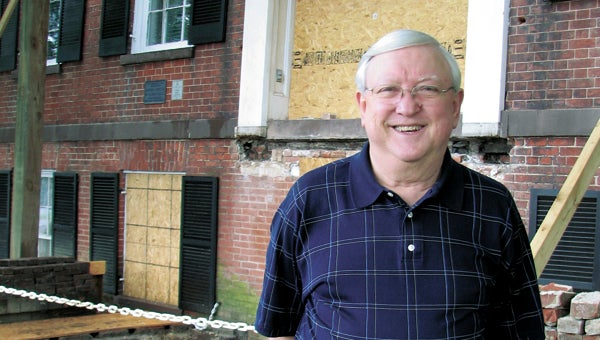Pottery shards discovered during museum work
Published 10:18 pm Friday, May 24, 2013

Lee King, director and curator at Riddick’s Folly, shows off the work being done on the museum’s steps, which were original to the early 1830s building.
An effort to replace the deteriorating steps at local house museum Riddick’s Folly has unearthed more clues to how the Riddicks and their contemporaries lived.
A contractor working for the city, which owns the building, has carefully dismantled the porch and steps at the front of the house, which stands near the corner of Main Street and Constance Road.
That process yielded some minor surprises.
“We’ve found out they were not concrete,” curator Lee King said of the original steps, which were built with the house in 1837. “They were actually brownstone, we think from New York.”
But the real surprise came when the company finished dismantling the steps and porch and began to dig deeper to do a soil stability study and pour the concrete footer.
About three feet down, small shards of pottery began to turn up. Some have ornate blue-and-white flower designs; others are blue-and-gray stoneware; another is simply gray with “Fox” or “Cox” imprinted in the piece.
King believes the pieces came from the former house on the property, which was destroyed by fire in 1837. Mills Riddick subsequently used his insurance settlement for several of his buildings that burned in the fire — about $5,600 — to pay for the construction of his new home, which locals dubbed a “folly” because of its massive size.
He and his wife, Mary Taylor Riddick, had 10 children who lived to adulthood. When he died in 1844, she moved into a smaller home nearby. The home fell to her children in equal shares, but Nathaniel Riddick purchased his siblings’ shares and moved in with his wife, Missouri. He was a lawyer and used the home for his practice until he built a separate office on the property.
Nathaniel Riddick would go on to serve in the Virginia House of Delegates and as a judge. The Union Army used the house as a headquarters during its occupation of Suffolk during the Civil War. Nathaniel Riddick died in 1882. The home now serves as a museum about the Riddicks and their contemporaries, as well as Suffolk during the Civil War.
King said he hopes to be able to sift through the pile of dirt in front of the house to find all the pieces of pottery that have been unearthed.
“It shows us what they used,” he said.
As for the steps, they will be rebuilt with the original bricks, which have been numbered so they can be replaced in their original order. King said another piece of evidence uncovered during the work indicates crumbling steps at the house isn’t just a 21st-century problem.
“We found evidence a big corner had broken off, I think around 1880, and had been pegged back on,” King said. “They may have had problems with these steps all along.”





